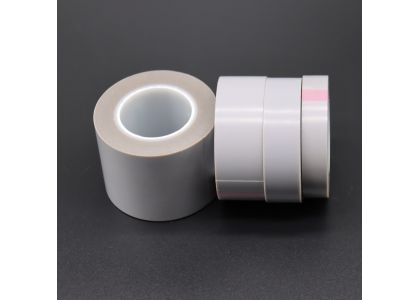
The demand for advanced masking and insulation materials has never been higher in today’s fast-paced manufacturing landscape. PTFE Film Adhesive Tape, a fusion of high-performance ptfe film tape substrate and precision silicone adhesive, delivers unparalleled reliability under extreme conditions. Commonly known as PTFE Film Tape Silicone Adhesive, this cutting-edge solution harnesses the electrical insulation and non-stick surface of an excellent white ptfe film tape while guaranteeing the uniformity and strength benefits of ptfe skived film tape. In this comprehensive article, we delve into its core material properties, explore detailed industry use cases in electronics, automotive, and aerospace sectors, and outline best practices—ensuring you optimize process efficiency, minimize downtime, and achieve truly residue-free results with every application.
One of the most celebrated features of ptfe film tape is its extraordinary thermal stability. Crafted from pure PTFE, the substrate withstands continuous exposure up to 260 °C and brief peaks surpassing 300 °C. This makes PTFE Film Adhesive Tape the go-to choice for:
Wave soldering processes, where molten solder temperatures can reach 260 °C.
Powder coating operations, requiring stable masking materials in curing ovens.
Composite curing cycles, where aerospace components must endure high-heat autoclave conditions.
By selecting PTFE Film Tape Silicone Adhesive, engineers eliminate tape degradation and adhesive bleeding—even in the most demanding heat-intensive environments.
Beyond temperature extremes, industrial settings often expose materials to aggressive chemicals. The specialized silicone adhesive layer in PTFE Film Adhesive Tape resists common solvents (e.g., acetone, isopropanol), strong acids (e.g., sulfuric, hydrochloric), and alkalis (e.g., sodium hydroxide). When paired with the inert nature of ptfe film tape, the combination provides:
Long-term adhesion in corrosive spray booths.
Protection against chemical overspray in battery manufacturing.
Secure masking during aggressive acid etching processes.
This dual-layer defense ensures that PTFE Film Tape Silicone Adhesive maintains bond integrity without degradation, dramatically reducing process interruptions.
A hallmark advantage of ptfe skived film tape is its ability to peel away cleanly. The micro-lubrication effect between the PTFE layer and silicone adhesive balances adhesion and release forces, enabling:
Seamless peel-off after high-temperature cycles.
No adhesive transfer or sticky residue on delicate surfaces.
Reduced cleaning time, lowering labor costs and throughput delays.
Whether protecting circuit boards or masking painted surfaces, PTFE Film Tape Silicone Adhesive eliminates the headache of post-process cleanup.
Manufactured via precision skiving, excellent white ptfe film tape ranges uniformly between 0.05 mm and 0.20 mm in thickness. This consistency provides:
Predictable adhesion and removal characteristics across large-area applications.
Even pressure distribution, preventing localized stress points.
Reliable mechanical strength for repeated peel tests and handling.
Engineers relying on PTFE Film Adhesive Tape can trust that each roll delivers the same high performance from the first meter to the last.
Application: During wave solder operations, apply ptfe skived film tape along PCB edges to shield traces and components from solder splatter.
Benefit: The tape’s high dielectric strength and perfect peel-off protect delicate solder joints, preventing flux residue and eliminating costly rework cycles.
Process Improvement: By using PTFE Film Tape Silicone Adhesive, manufacturers see a 30% reduction in post-solder cleaning time.
Quality Assurance: Consistent thickness and no-residue removal ensure zero contamination on contact pads.
Application: Utilize ptfe film adhesive tape to mask interior trims and exterior panels prior to powder coating or spray painting.
Benefit: The combination of heat resistance and clean removal produces razor-sharp paint lines without edge buildup or scuff marks, elevating finish quality.
Efficiency Gain: Automotive plants report up to 20% faster tape removal rates compared to conventional masking tapes.
Waste Reduction: Less adhesive waste leads to lower material consumption and disposal costs.
Application: In composite layup, deploy PTFE Film Tape Silicone Adhesive as a lightweight release liner, preventing resin adhesion to mold surfaces.
Benefit: Its thermal endurance up to 260 °C makes it ideal for both curing and post-cure processes, while residue-free pull-away accelerates mold turnaround times.
Cycle Time Improvement: Aerospace shops achieve a 15% faster mold release, boosting overall throughput.
Cost Savings: Reduced mold cleaning translates to extended mold life and lower maintenance budgets.
Surface Preparation
Ensure all substrates are clean, dry, and free from oil or dust. Contaminants can compromise the bond of ptfe film tape, leading to uneven coverage and potential edge lifting.
Correct Application Pressure & Dwell Time
Apply tape at ambient temperatures (20 °C–25 °C) with approximately 1–2 kg/cm² pressure.
Allow a 5–10 minute dwell before heat exposure so the silicone adhesive fully wets the surface, optimizing bond strength.
Ideal Peel Technique
Remove tape at a steady 90° angle at moderate speed.
Avoid rapid or angled pulls that may leave adhesive residue or damage delicate surfaces.
Proper Storage Conditions
Store rolls of excellent white ptfe film tape in a cool (below 30 °C), dry location away from direct sunlight.
Maintain relative humidity below 60% to preserve adhesive properties over extended periods.
Recycling and Reuse: Many facilities implement simple ultrasonic or solvent-based cleaning processes to recover up to 80% of ptfe skived film tape material, slashing landfill waste and material expenses.
Long-Term ROI: Although PTFE Film Adhesive Tape may carry a higher unit cost than generic masking tapes, its durability, no-residue removal, and reduced rework deliver a measurable return on investment—often within the first production quarter.
By harnessing the unique capabilities of PTFE Film Adhesive Tape, manufacturers across electronics, automotive, and aerospace industries unlock new levels of efficiency and quality. From the high-temperature resilience of ptfe film tape to the crystal-clean removal of PTFE Film Tape Silicone Adhesive, this versatile solution addresses the most demanding masking and insulation challenges. Integrate excellent white ptfe film tape and ptfe skived film tape into your processes today to minimize downtime, reduce waste, and elevate product performance—solidifying your competitive edge in modern industrial applications.